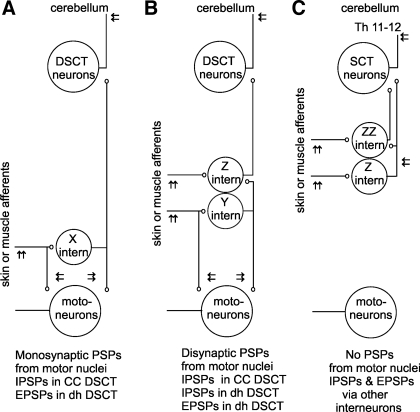Fig. 1.
Diagram of possible relays of actions of peripheral afferents on dorsal spinocerebellar tract (DSCT) and spinocervical tract (SCT) neurons. Large circles represent DSCT neurons projecting to the cerebellum, SCT neurons terminating in the lateral cervical nucleus in the C3–4 segments and hindlimb motoneurons. Smaller circles represent interneurons that might mediate disynaptic or trisynaptic actions evoked by stimulation of peripheral nerves. A: neuronal pathways via interneurons X (excitatory or inhibitory) exerting direct actions on hindlimb motoneurons and on ascending tract neurons. B: neuronal pathways via interneurons Y (excitatory) acting directly on motoneurons but only indirectly on ascending tract neurons, via interneurons Z (excitatory or inhibitory). C: neuronal pathways via interneurons Z and ZZ (excitatory and inhibitory) that do not project to motor nuclei but might relay disynaptic and trisynaptic effects of primary afferents, being excited by the afferents either directly or indirectly. Arrows indicate sites of application of stimuli to the peripheral nerves, in the motor nuclei or dorsal to them, to the lateral funiculus at the Th 11–12 level and within the cerebellum, as indicated. PSPs evoked via these pathways are indicated at the bottom.

